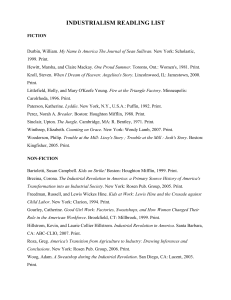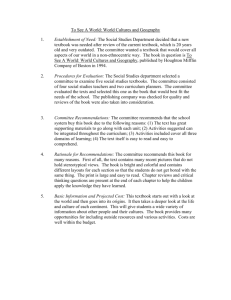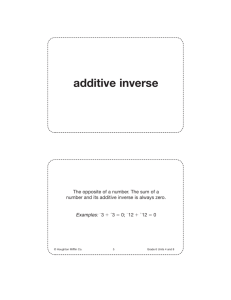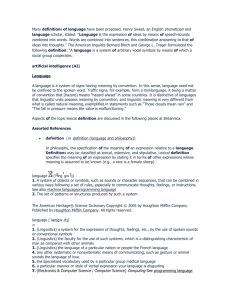large
advertisement
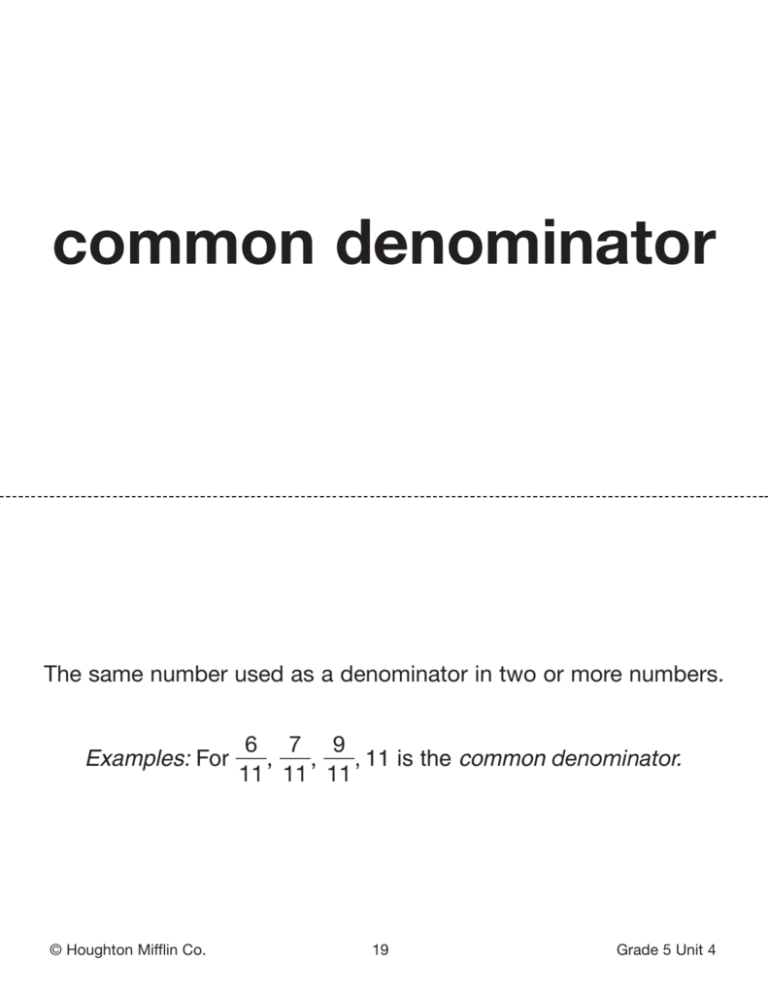
common denominator The same number used as a denominator in two or more numbers. 6 7 9 Examples: For ᎏᎏ, ᎏᎏ, ᎏᎏ, 11 is the common denominator. 11 11 11 © Houghton Mifflin Co. 19 Grade 5 Unit 4 common factor A number that is a factor of two or more numbers. Example: 4 is a common factor of 8, 20, and 40. © Houghton Mifflin Co. 20 Grade 5 Unit 4 common multiple A number that is a multiple of two or more numbers. Example: 60 is a common multiple of 10,12, and 15. © Houghton Mifflin Co. 21 Grade 5 Unit 4 composite number A whole number that has more than two factors. Examples: 24, 9, and 784 are composite numbers. © Houghton Mifflin Co. 25 Grade 5 Unit 4 decimal point A symbol used to separate the ones and tenths places in a decimal. Example: 4.2365 decimal point © Houghton Mifflin Co. 37 Grade 5 Units 1, 4 equivalent fractions Fractions that show different numbers with the same value. 4 8 12 Example: ᎏᎏ, ᎏᎏ, ᎏᎏ are all equivalent. 5 10 15 © Houghton Mifflin Co. 51 Grade 5 Unit 4. factor Two or more numbers that are multiplied to give a product. Example: 46 ⫻ 3 ⫽ 138 factors © Houghton Mifflin Co. 60 Grade 5 Units 2, 4, 5 fraction A number that names a part of a whole, a part of a collection, or part of a region. 1 2 5 Example: ᎏᎏ, ᎏᎏ, and ᎏᎏ are fractions. 2 3 7 © Houghton Mifflin Co. 61 Grade 5 Unit 4 greatest common divisor (GCD) The greatest whole number that is a common factor of two or more numbers. It is also called the greatest common factor. Example: 15 is the greatest common divisor of 30, 45, and 60. © Houghton Mifflin Co. 68 Grade 5 Unit 4 greatest common factor (GCF) The greatest whole number that is a common factor of two or more numbers. It is also called the greatest common divisor. Example: 4 is the greatest common factor of 8 and 12. © Houghton Mifflin Co. 69 Grade 5 Unit 4 hundredths The place value of the digit two places to the right of a decimal point. Example: In 0.572, the digit in the hundredths place is 7. © Houghton Mifflin Co. 71 Grade 5 Unit 4 improper fraction A fraction which has a numerator that is greater than or equal to its denominator. 15 Example: ᎏᎏ is an improper fraction. 7 © Houghton Mifflin Co. 75 Grade 5 Units 4, 5 least common denominator (LCD) The least common multiple of two or more denominators. 5 2 Example: 30 is the least common denominator for ᎏᎏ and ᎏᎏ. 6 15 © Houghton Mifflin Co. 81 Grade 5 Unit 4 least common multiple (LCM) The smallest multiple that is common to two or more numbers. Example: 24 is the least common multiple of 8 and 12. © Houghton Mifflin Co. 82 Grade 5 Unit 4 mixed number A number made up of a whole number and a fraction. 3 1 5 Examples: 3ᎏᎏ, 17ᎏᎏ, and 108ᎏᎏ are mixed numbers. 4 8 6 © Houghton Mifflin Co. 90 Grade 5 Units 4, 5 multiple A number that is the product of the given number and a counting number. Example: 24 is a multiple of 6. © Houghton Mifflin Co. 92 Grade 5 Unit 4 prime factorization Writing a number as the product of prime factors. Example: 2 ⫻ 33 ⫻ 5 is the prime factorization of 270. © Houghton Mifflin Co. 116 Grade 5 Unit 4 prime number A whole number greater than 1 that has exactly two factors, 1 and itself. Examples: 2, 3, 5, 7, 11, 13,… are prime numbers. © Houghton Mifflin Co. 117 Grade 5 Unit 4 round To find about how many or how much by expressing a number to the nearest ten, hundred, thousand, and so on. Examples: 2,349 rounded to the nearest hundred is 2,300. © Houghton Mifflin Co. 140 Grade 5 Unit 4 simplest form A fraction is in simplest form when the GCF of the numerator and the denominator is 1. 9 3 Example: The simplest form of ᎏᎏ is ᎏᎏ. 12 4 © Houghton Mifflin Co. 146 Grade 5 Units 4, 7 unit fraction A fraction in which the numerator is 1. 1 1 1 Examples: ᎏᎏ, ᎏᎏ, and ᎏᎏ are unit fractions. 15 4 19 © Houghton Mifflin Co. 169 Grade 5 Units 4, 5



